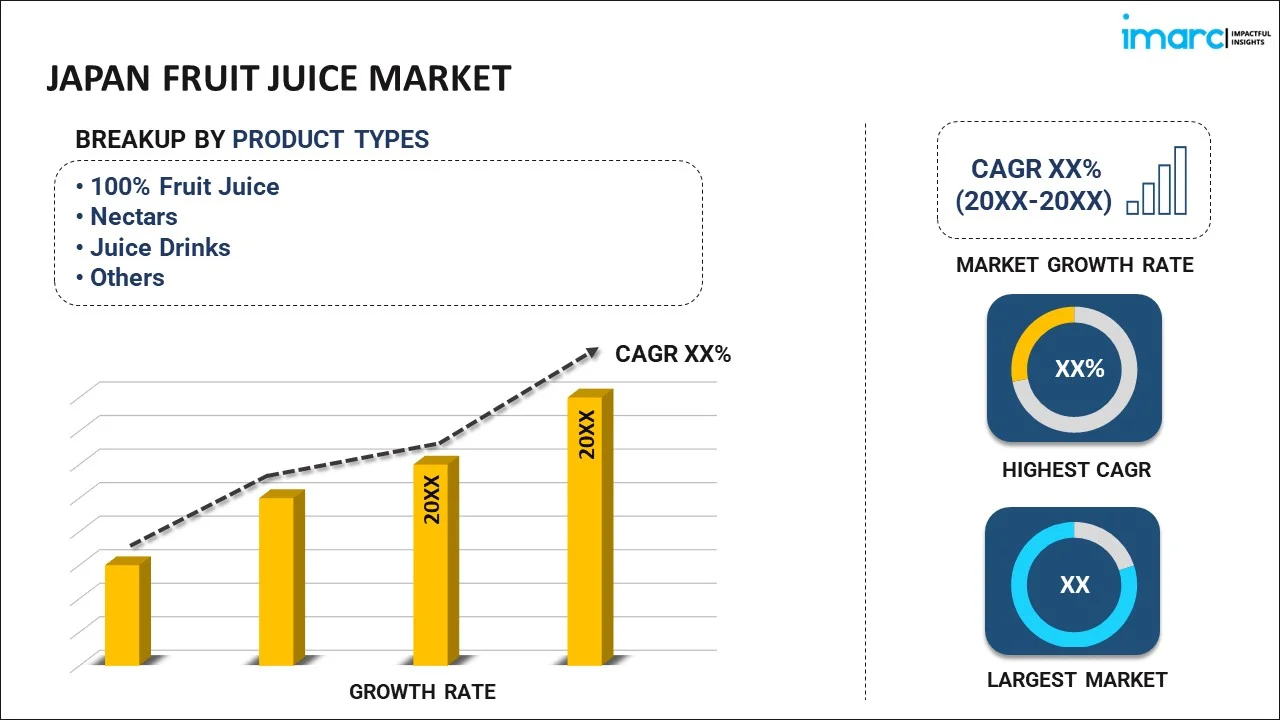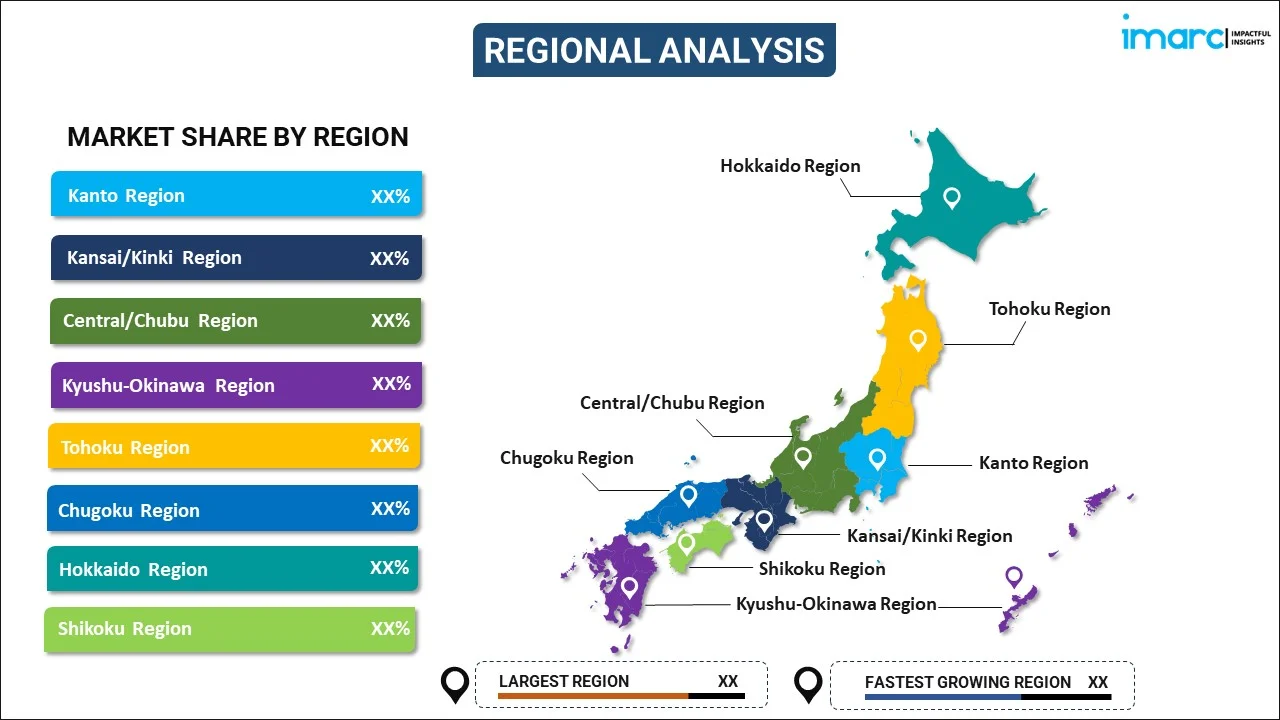
Japan Fruit Juice Market Report by Product Type (100% Fruit Juice, Nectars, Juice Drinks, Concentrates, Powdered Juice, and Others), Flavor (Orange, Apple, Mango, Mixed Fruit, and Others), Distribution Channel (Supermarkets and Hypermarkets, Convenience Stores, Specialty Food Stores, Online Retail, and Others), and Region 2025-2033
Market Overview:
Japan fruit juice market size reached USD 9.4 Billion in 2024. Looking forward, IMARC Group expects the market to reach USD 12.6 Billion by 2033, exhibiting a growth rate (CAGR) of 3.3% during 2025-2033. The rising prevalence of urbanization and busy lifestyles, which have led to an increased demand for convenient and ready-to-drink beverages, positioning fruit juices as a convenient and refreshing option, is driving the market.
|
Report Attribute
|
Key Statistics
|
|---|---|
|
Base Year
|
2024
|
|
Forecast Years
|
2025-2033
|
|
Historical Years
|
2019-2024
|
|
Market Size in 2024
|
USD 9.4 Billion |
|
Market Forecast in 2033
|
USD 12.6 Billion |
| Market Growth Rate 2025-2033 | 3.3% |
Fruit juice is a refreshing beverage derived from the liquid content of fruits, extracted through processes like pressing, squeezing, or centrifugation. This delicious and often nutritious drink has been enjoyed by humans for centuries. As a natural source of vitamins, minerals, and antioxidants, fruit juice offers a convenient way to consume essential nutrients. The extraction process varies depending on the type of fruit, with popular choices including orange, apple, grape, and pineapple juice. While some juices are consumed fresh, others undergo pasteurization or concentration for longer shelf life. Despite its widespread popularity, it's essential to note that some commercially available fruit juices may contain added sugars or preservatives, impacting their nutritional value. As consumer awareness of health considerations increases, there is a growing trend toward seeking pure, minimally processed fruit juices as a flavorful and healthful beverage choice.
Japan Fruit Juice Market Trends:
The fruit juice market in Japan is experiencing robust growth, driven by several key factors. Firstly, the increasing regional awareness of health and wellness has led consumers to seek healthier beverage options, propelling the demand for natural fruit juices. Moreover, the growing emphasis on a balanced lifestyle and nutrition has fueled a preference for beverages that offer both taste and nutritional benefits. Additionally, the rising trend of convenience in modern lifestyles has boosted the popularity of ready-to-drink fruit juices, providing consumers with a quick and nutritious refreshment option. Furthermore, the ongoing innovations in flavor combinations and packaging designs have contributed to expanding consumer choices, making the market more dynamic and appealing. The surge in disposable income across various demographic segments has also played a pivotal role in driving the fruit juice market, as consumers are more willing to invest in premium and value-added products. Moreover, the regional trend towards sustainable and eco-friendly practices, which has prompted the development of organic and environmentally conscious fruit juice options, is expected to drive the fruit juice market in Japan during the forecast period.
Japan Fruit Juice Market Segmentation:
IMARC Group provides an analysis of the key trends in each segment of the market, along with forecasts at the country level for 2025-2033. Our report has categorized the market based on product type, flavor, and distribution channel.
Product Type Insights:

- 100% Fruit Juice
- Nectars
- Juice Drinks
- Concentrates
- Powdered Juice
- Others
The report has provided a detailed breakup and analysis of the market based on the product type. This includes 100% fruit juice, nectars, juice drinks, concentrates, powdered juice, and others.
Flavor Insights:
- Orange
- Apple
- Mango
- Mixed Fruit
- Others
A detailed breakup and analysis of the market based on the flavor have also been provided in the report. This includes orange, apple, mango, mixed fruit, and others.
Distribution Channel Insights:
- Supermarkets and Hypermarkets
- Convenience Stores
- Specialty Food Stores
- Online Retail
- Others
The report has provided a detailed breakup and analysis of the market based on the distribution channel. This includes supermarkets and hypermarkets, convenience stores, specialty food stores, online retail, and others.
Regional Insights:

- Kanto Region
- Kansai/Kinki Region
- Central/ Chubu Region
- Kyushu-Okinawa Region
- Tohoku Region
- Chugoku Region
- Hokkaido Region
- Shikoku Region
The report has also provided a comprehensive analysis of all the major regional markets, which include Kanto Region, Kansai/Kinki Region, Central/ Chubu Region, Kyushu-Okinawa Region, Tohoku Region, Chugoku Region, Hokkaido Region, and Shikoku Region.
Competitive Landscape:
The market research report has also provided a comprehensive analysis of the competitive landscape. Competitive analysis such as market structure, key player positioning, top winning strategies, competitive dashboard, and company evaluation quadrant has been covered in the report. Also, detailed profiles of all major companies have been provided. Some of the key players include:
- Calpis Co., Ltd.
- Nippon Del Monte Corporation
- Suntory Beverage & Food Limited (Suntory Holdings Limited)
- Yakult Honsha Co., Ltd.
(Please note that this is only a partial list of the key players, and the complete list is provided in the report.)
Japan Fruit Juice Market Report Coverage:
| Report Features | Details |
|---|---|
| Base Year of the Analysis | 2024 |
| Historical Period | 2019-2024 |
| Forecast Period | 2025-2033 |
| Units | Billion USD |
| Scope of the Report | Exploration of Historical and Forecast Trends, Industry Catalysts and Challenges, Segment-Wise Historical and Predictive Market Assessment:
|
| Product Types Covered | 100% Fruit Juice, Nectars, Juice Drinks, Concentrates, Powdered Juice, Others |
| Flavors Covered | Orange, Apple, Mango, Mixed Fruit, Others |
| Distribution Channels Covered | Supermarkets and Hypermarkets, Convenience Stores, Specialty Food Stores, Online Retail, Others |
| Regions Covered | Kanto Region, Kansai/Kinki Region, Central/ Chubu Region, Kyushu-Okinawa Region, Tohoku Region, Chugoku Region, Hokkaido Region, Shikoku Region |
| Companies Covered | Calpis Co., Ltd., Nippon Del Monte Corporation, Suntory Beverage & Food Limited (Suntory Holdings Limited), Yakult Honsha Co., Ltd., etc. |
| Customization Scope | 10% Free Customization |
| Post-Sale Analyst Support | 10-12 Weeks |
| Delivery Format | PDF and Excel through Email (We can also provide the editable version of the report in PPT/Word format on special request) |
Key Questions Answered in This Report:
- How has the Japan fruit juice market performed so far and how will it perform in the coming years?
- What has been the impact of COVID-19 on the Japan fruit juice market?
- What is the breakup of the Japan fruit juice market on the basis of product type?
- What is the breakup of the Japan fruit juice market on the basis of flavor?
- What is the breakup of the Japan fruit juice market on the basis of distribution channel?
- What are the various stages in the value chain of the Japan fruit juice market?
- What are the key driving factors and challenges in the Japan fruit juice?
- What is the structure of the Japan fruit juice market and who are the key players?
- What is the degree of competition in the Japan fruit juice market?
Key Benefits for Stakeholders:
- IMARC’s industry report offers a comprehensive quantitative analysis of various market segments, historical and current market trends, market forecasts, and dynamics of the Japan fruit juice market from 2019-2033.
- The research report provides the latest information on the market drivers, challenges, and opportunities in the Japan fruit juice market.
- Porter's five forces analysis assist stakeholders in assessing the impact of new entrants, competitive rivalry, supplier power, buyer power, and the threat of substitution. It helps stakeholders to analyze the level of competition within the Japan fruit juice industry and its attractiveness.
- Competitive landscape allows stakeholders to understand their competitive environment and provides an insight into the current positions of key players in the market.
Need more help?
- Speak to our experienced analysts for insights on the current market scenarios.
- Include additional segments and countries to customize the report as per your requirement.
- Gain an unparalleled competitive advantage in your domain by understanding how to utilize the report and positively impacting your operations and revenue.
- For further assistance, please connect with our analysts.
 Inquire Before Buying
Inquire Before Buying
 Speak to an Analyst
Speak to an Analyst
 Request Brochure
Request Brochure
 Request Customization
Request Customization




.webp)




.webp)












